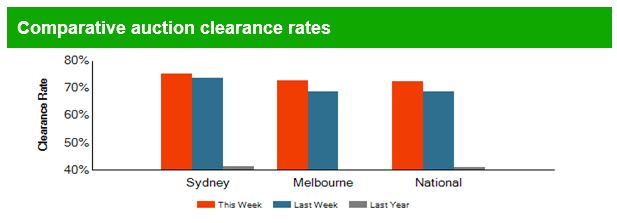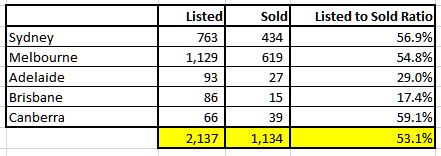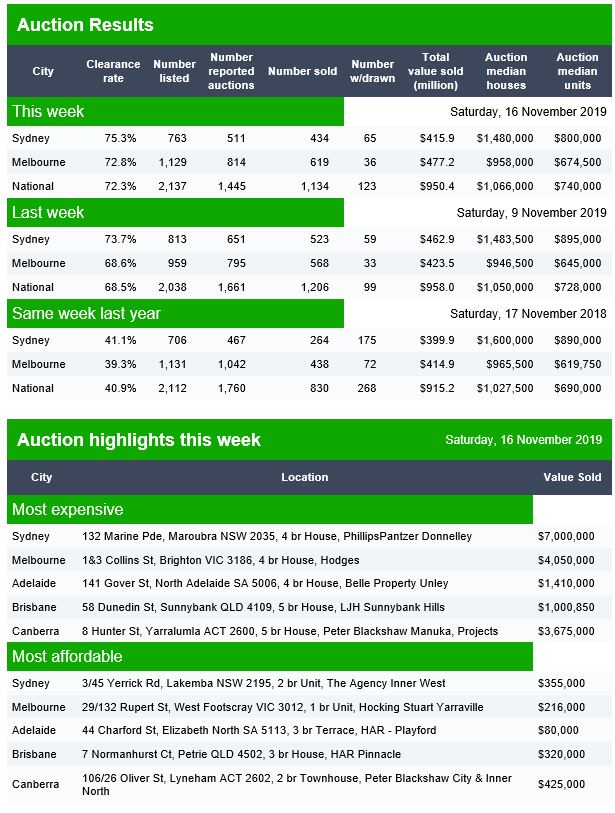I discuss housing bubbles with Joseph Walker, of The Jolly Swagman Podcast fame.
Category: Economics and Banking
Auction Results 16 Nov 2019
Domain released their preliminary results for today.

The latest results continue the high clearance rates, with volumes now tracking closely to those a year ago (when momentum had ebbed away).

Canberra listed 66 auctions, reported 54 and sold 39, with 3 withdrawn and 15 passed, giving a Domain clearance of 68%.
Brisbane listed 86 auctions, reported 34 and sold 15, with 14 withdrawn and 5 passed in, giving an Domain clearance of 38%.
Adelaide listed 93 auctions, reported 32 and sold 27, with 14 withdrawn and 5 passed in, giving a Domain clearance of 59%.
DFA’s additional calculation:

Interestingly, the number of auctions advertised before the day was around 480, compared with the 763 reported in Sydney.

To Infinity And Beyond – The Property Imperative Weekly 16 Nov 2019
The latest edition of our weekly finance and property news digest with a distinctively Australian flavour.
Contents
0:20 Introduction
1:05 Live Stream 19th Nov
1:30 US
2:00 US China Trade
2:50 US Economy
3:10 CASS Shipping
4:40 Fed Policy
5:20 US Markets
07:57 Hong Kong
8:25 UK
09:35 New Zealand
11:22 Australian Section
11:23 Employment
12:00 Wages
13:20 Sentiment
14:00 Home Prices
17:18 Auctions
17:50 Pay Day Research
19:10 Insolvencies
20:00 RBA on Mortgage Arrears
22:35 Australian Markets
November Live stream: https://youtu.be/dMaixx5Sf34
More Treasury Cash Ban Tricks – KPMG
The latest on the Cash Restrictions Bill – with Treasury hiding a key submission from KPMG, the architect of the ban… I discuss with Robbie Barwick from the Citizens Party.
Still time to make a submission – just….
https://www.aph.gov.au/Parliamentary_Business/Committees/Senate/Economics/CurrencyCashBill2019
Public Disclosure Proves That Treasury Lied To And Misled The Government
Economist John Adams and Analyst Martin North examines the latest disclosures relating to the Cash Transaction Restriction Bill, and considers the implications in the count down to the end of the Senate submission window which expires on 15th November.
The Future Of Your Savings!
We examine a recent article which highlights how Central Banks are crushing savers.
Did The End Of The World Just Get Postponed?
Something happened late last week, which superficially might be attributed to positive news on the US China trade talks (later downplayed by Trump) but it was wider and more significant than that.
In recent months many traders have been positioning for a significant market correction, and potentially a US or global recession. Thus, risk stocks were downplayed, while bonds and gold were all the rage.
This drove the yields on bonds down, to the point where in several countries, like Germany they went negative, and at its peak, it was estimated that around $17 trillion of bonds were effectively underwater. A couple of weeks back, we pointed out that Gold had shot ahead of itself, and that the Gold futures meant it would slide. It did, falling by more than $30 an ounce.
The 10-year US Treasury yield rose on Friday to 1.94%. up nearly 50 basis points from the lows at the end of August. Remember that the Fed cut its interest rate target twice, by a total of 50 basis points, and short-term Treasury yields have fallen by about that much. With the one-month yield now down to 1.56% and the 10-year yield up at 1.94%, the yield curve has un-inverted and steepened. Recession has been postponed, for now.
Germany’s 30-year bonds are interesting in that they tried to sell them at a negative yield of -0.11% on August 21, with a 0% coupon – so no interest payments for 30 years – and at a premium, in order to achieve the negative yield of -0.11%. While €2 billion of these bonds were offered, only €824 million were sold. And those investors may rue the day they bought.

We discuss the underling issues.
Does Monetary Policy Work Any More?
In its quarterly statement on monetary policy, released today, the Reserve Bank of Australia declared its preparedness to “ease monetary policy further if needed”. Via The Conversation.

This suggests the bank still thinks monetary policy – in this case lowering interest rates to stimulate the economy – could help “support sustainable growth in the economy, full employment and the achievement of the medium-term inflation target”.
But in the wake of the bank last month lowering the official interest rate to a record low and the current somewhat sad state of the Australian economy, many commentators have speculated that monetary policy doesn’t work any more.
Is that right?
Reserve Bank cash rate

There are a number of variants of the “monetary policy doesn’t work” argument. The most basic is that the Reserve Bank has this year cut rates from 1.50% to 0.75% without any improvement to the Australian economy.
This is a textbook example of one of the classic logic fallacies known as “post hoc ergo propter hoc” (from the Latin, meaning “after this, therefore because of this”).
Put simply, it assumes the rate cuts have had no effect and doesn’t account for the possibility things might have been worse had there been no cuts.
Things might have been even worse. We’ll never know.
It also ignores what might have happened if the RBA had cut sooner. Again, we can’t know for sure. It is possible, though, to make an educated guess.
When to cut rates
Had Reserve Bank governor Philip Lowe acted, say, 18 months earlier to cut rates, he would have signalled that Gross Domestic Product growth was indeed lower than desired, that the sustainable rate of unemployment was more like 4.5% than 5%, and, most importantly, that he understood the need to act decisively.
That would have sent a powerful signal.
It would also have ameliorated the huge decline in housing credit that pushed down housing prices in Sydney and Melbourne by double digits.
That, in turn, would have prevented some of the weakening in the balance sheets of the big four banks that has occurred (witness this annual general meeting season).
All of this would have pumped more liquidity into the economy and put households in a much stronger position, likely leading to stronger consumer spending than we have seen.
Bank pass through
One gripe both the Reserve Bank governor Philip Lowe and federal treasurer Josh Frydenberg have had with the banks is their failure to fully pass through the RBA cuts.
It is true there is a problem with banks not being able to cut deposit rates below zero, and as a result having less scope to cut mortgage rates, which are majority funded from deposits.
But there are, of course, other ways monetary policy can work. The leading example is quantitative easing (QE).
This is where the central bank pushes down long-term interest rates by buying government and corporate bonds. At the same time this expands the money supply, thereby adding some upward inflationary pressure.
There is little reason to think such measures wouldn’t work.
The power of free money
Perhaps paradoxically, the closer interest rates get to zero the more powerful those rates may end up being.
To put it bluntly, if someone shoves a pile of money into your hand and asks almost nothing in return, you’re likely to use it. In fact, you would be pretty silly not to.
Suppose your mortgage rate really goes to zero – as has happened in Europe.
You might decide to redraw that and spend the money on a home renovation or some other productive purpose. Or you might decide to buy a more expensive house.
Such spending provides an economic boost.
The effect is all the more pronounced if people expect interest rates to be low for a long period of time. Aggressive cutting coupled with quantitative easing – which lowers long-term rates – signal just that.
But not only monetary policy
Just because monetary policy still has some effect at near-zero rates doesn’t mean we should pin all of our economic hopes to it.
A near consensus of economists have argued repeatedly for the use of more aggressive fiscal policy – including more infrastructure spending and more tax cuts.
Indeed, Philip Lowe has raised eyebrows by speaking so forthrightly on this issue. That doesn’t make him wrong, though.
There is little doubt the Reserve Bank should have acted much earlier to cut official interest rates. There is also a very good chance it will need to begin to use other measures such as quantitative easing in the relatively near future.
All of that says the Australian economy, like most advanced economies around the world, is in bad shape.
But it doesn’t mean monetary policy has completely run out of puff.
Author: Richard Holden, Professor of Economics, UNSW
30,000 And Counting..!
Thanks to the community we have reached 30,000 subscribers on YouTube.
I really appreciate your support and participation. Here’s to the next 20,000!
The Roller Coaster Ride Continues – The Property Imperative Weekly 09 Nov 2019
The latest edition of our weekly finance and property news digest with a distinctively Australian flavour.
Contents:
00:24 Introduction
1:23 US China Trade Talks
3:04 US Markets
6:15 China
7:50 Australian Section
7:55 RBA on Monetary Policy
10:50 Household Confidence
11:10 Lending
11:40 REA
14:50 High Rise Construction
15:30 Property Market
16:20 Auctions
16:50 Bank Profit Results
17:50 Australian Markets
